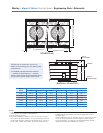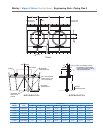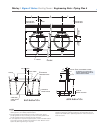
Marley
/
Sigma F Series Cooling Tower
/
Engineering Data: Environmental
11
Sound Control
Sound produced by a Sigma tower operating in an unobstructed
environment will meet all but the most restrictive noise limita-
tions—and will react favorably to natural attenuation. Where the
tower has been sized to operate within an enclosure, the enclosure
itself will have a damping effect on sound. Sound also declines with
distance—by about 5 dBA each time the distance doubles. Where
noise at a critical point is likely to exceed an acceptable limit, sev-
eral options are available—listed below in ascending order of cost
impact:
• In many cases, noise concerns are limited to nighttime,
when ambient noise levels are lower and neighbors are
trying to sleep. You can usually resolve these situations by
using two-speed motors in either 1800/900 or 1800/1200
RPM configuration—operating the fans at reduced speed
without cycling “after hours”. The natural nighttime reduc-
tion in wet-bulb temperature makes this a very feasible
solution in most areas of the world, but the need to avoid
cycling may cause the cold water temperature to vary signifi-
cantly.
• The Marley Variable Frequency Drive automatically mini-
mizes the tower’s noise level during periods of reduced load
and/or reduced ambient temperature without sacrificing the
system’s ability to maintain a constant cold water tempera-
ture. This is a relatively inexpensive solution, and can pay for
itself quickly in reduced energy costs.
• Where noise is a concern at all times—for example, near a
hospital—the best solution is to oversize the tower so it can
operate continuously at reduced (1200 or 900 RPM) motor
speed. Typical sound reductions are 7 dBA at
2
⁄3" fan speed
or 10 dBA at
1
⁄2" fan speed.
• Extreme cases may require inlet and discharge sound attenu-
ator sections—however, the static pressure loss imposed
by attenuators may necessitate an increase in tower size.
This is the least desirable approach because of the signifi-
cant cost impact—and because of the obstruction to normal
maintenance procedures.
Your Marley representative will help you meet your sound
requirements.
Enclosures
Occasionally, cooling towers are located inside architectural
enclosures for aesthetic reasons. Although Sigma towers adapt
well to enclosures, the designer must realize the potential impact
of a poorly arranged enclosure on the tower’s performance and
operation. The designer must take care to provide generous air inlet
paths, and the tower’s fan cylinder discharge height should not be
lower than the elevation of the top of the enclosure. Obtain a copy
of Marley Technical Report #H-004, “External Influences on Cool-
ing Tower Performance” from your Marley sales representative or
on the web at spxcooling.com..
As suggested in the aforementioned Technical Report, it may
also be advisable to specify a design wet-bulb temperature 1°F
higher than normal to compensate for potential recirculation initi-
ated by the enclosure. You’ll benefit from discussing your project
with your Marley representative.
Keeping It Clean
Cooling towers are very effective air washers. Atmospheric
dust able to pass through the relatively small louver openings will
enter the circulating water system. Increased concentrations can
intensify system maintenance by clogging screens and strainers—
and smaller particulates can coat system heat transfer surfaces. In
areas of low flow velocity—such as the cold water basin—sedimen-
tary deposits can provide a breeding ground for bacteria.
In areas prone to dust and sedimentation, you should consider
installing some means for keeping the cold water basin clean.
Typical devices include side stream filters and a variety of filtration
media.
Water Treatment
To control the buildup of dissolved solids resulting from water
evaporation, as well as airborne impurities and biological contami-
nants including Legionella, an effective consistent water treatment
program is required. Simple blowdown may be adequate to control
corrosion and scale, but biological contamination can only be con-
trolled with biocides.
An acceptable water treatment program must be compatible
with the variety of materials incorporated in a cooling tower—ide-
ally the pH of the circulating water should fall between 6.5 and 8.0.
Batch feeding of chemicals directly into the cooling tower is not
a good practice since localized damage to the tower is possible.
Specific startup instructions and additional water quality recom-
mendations can be found in the Sigma User Manual which accom-
panies the tower and also is available from your local Marley sales
representative. For complete water treatment recommendations
and services, contact your local Marley sales representative.


















